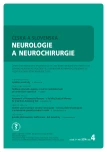Validation of the Minimum Question Set for the Diagnosis of the Restless Legs Syndrome in a Population of Czech Pregnant Women
Authors:
Z. Šrůtková; J. Pavlíčková; L. Plchová; K. Šonka; A. Pařízek; D. Kemlink
Authors‘ workplace:
Neurologická klinika a Centrum klinických neurověd 1. LF UK a VFN v Praze
Published in:
Cesk Slov Neurol N 2014; 77/110(4): 493-495
Category:
Short Communication
Overview
Aims:
The aim of this study was to estimate diagnostic accuracy of the Czech version of a self-administered minimum question set to diagnose the Restless Legs Syndrome (RLS). The wording of the three questions was published in 2003 by the International RLS study group together with the diagnostic criteria.
Material and methods:
The question set was translated into Czech, followed by blind translation back to English. Women in 36th–38th week of pregnancy were asked to complete the questionnaire. Subsequently, the women were contacted over a telephone by a physician trained in diagnosing RLS and a standard telephone interview to establish or exclude the diagnosis of RLS was performed. The results of both methods were compared to estimate sensitivity, specificity, positive and negative predictive values of the minimum question set.
Results:
We surveyed 776 pregnant women (18–49 years old) who came to a prenatal outpatient clinic to consult an obstetrician at the third trimester (36th–38th week of pregnancy). In total, 199 questionnaires were validated; personal interview confirmed the diagnosis of RLS in 65 of them. Positive response to all three questions yields specificity of 89% but only about 78% sensitivity and positive predictive value. Positive response to the first question only has sensitivity of 94% and negative predictive value of 96%. The prevalence of RLS during pregnancy estimated using the three-question questionnaire was 28% (95% confidence interval from 24.9 to 31.2%).
Conclusion:
Our study validated the Czech version of the minimal question set for diagnosing RLS and confirmed its high diagnostic accuracy.
Key words:
restless legs syndrome – pregnancy – sensitivity – specificity – prevalence
Sources
1. Allen RP, Walters AS, Montplaisir J, Hening W, Myers A, Bell TJ et al. Restless legs syndrome prevalence and impact: REST general population study. Arch Intern Med 2005; 165(11): 1286– 1292.
2. Hening W, Walters AS, Allen RP, Montplaisir J, Myers A, Ferini‑Strambi L. Impact, diagnosis and treatment of restless legs syndrome (RLS) in a primary care population: the REST (RLS epidemiology, symptoms, and treatment) primary care study. Sleep Med 2004; 5(3): 237– 246.
3. Tison F, Crochard A, Leger D, Bouee S, Lainey E, El Hasnaoui A. Epidemiology of restless legs syndrome in French adults: a nationwide survey: the INSTANT Study. Neurology 2005; 65(2): 239– 246.
4. Manconi M, Govoni V, De Vito A, Economou NT, Cesnik E, Mollica G et al. Pregnancy as a risk factor for restless legs syndrome. Sleep Med 2004; 5(3): 305– 308.
5. Suzuki K, Ohida T, Sone T, Takemura S, Yokoyama E,Miyake T et al. The prevalence of restless legs syndrome among pregnant women in Japan and the relationship between restless legs syndrome and sleep problems. Sleep 2003; 26(6): 673– 677.
6. Allen RP, Picchietti D, Hening WA, Trenkwalder C,Walters AS, Montplaisi J. Restless legs syndrome: diagnostic criteria, special considerations, and epidemiology. A report from the restless legs syndrome diagnosis and epidemiology workshop at the National Institutes of Health. Sleep medicine 2003; 4(2): 101– 119.
7. Šonka K, Pretl M, Havránková P, Volná J, Dušek P, Salvet A et al. Úspěšné použití jediné otázky pro screening syndromu neklidných nohou v České republice. Cesk Slov Neurol N 2007; 70/ 103(6): 685– 686.
8. Minar M, Habanova H, Rusnak I, Planck K, Valkovic P. Prevalence and impact of restless legs syndrome in pregnancy. Neuro Endocrinol Lett 2013; 34(5): 366– 371.
9. Hubner A, Krafft A, Gadient S, Werth E, Zimmermann R, Bassetti CL. Characteristics and determinants of restless legs syndrome in pregnancy: a prospective study. Neurology 2013; 80(8): 738– 742. doi: 10.1212/ WNL.0b013e318283baf3.
10. Vahdat M, Sariri E, Miri S, Rohani M, Kashanian M,Sabet A et al. Prevalence and associated features of restless legs syndrome in a population of Iranian women during pregnancy. Int J Gynaecol Obstet 2013; 123(1): 46– 49. doi: 10.1016/ j.ijgo.2013.04.023.
Labels
Paediatric neurology Neurosurgery NeurologyArticle was published in
Czech and Slovak Neurology and Neurosurgery

2014 Issue 4
Most read in this issue
- Sensory Examination
- Genetic Variability in Attention Deficit Hyperactivity Disorder
- Spinal Arteriovenous Malformations – Two Case Reports
- The Value of Repeated Non-confirmatory Multiple Sleep Latency Test (MSLT) for the Diagnosis of Narcolepsy
